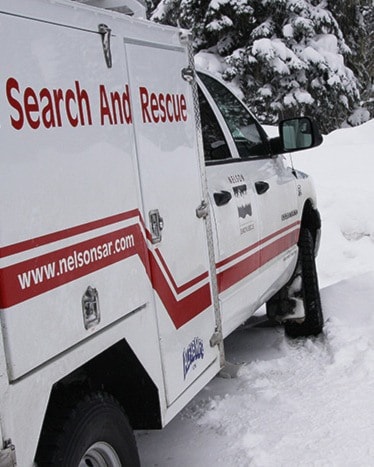It was a happy ending to a search for Ymir resident Edward Perello who was found by search and rescue in the Qua Basin near Whitewater on Thursday.
The 47 year-old man was found alive and mostly well on Thursday morning when SAR crews in a helicopter spotted him below waving his ski in the Qua Basin.
As for finding Perello alive after three nights in the mountains, Nelson Search and Rescue (NSAR) manager Chris Armstrong said Perello has “amazing power in him.”
“He was in dire straits; cold and hungry with no sleep for three days, but in good spirits to be found. He’s a tough bugger.”

NSAR and several other teams from the region began their search for the man when he was reported missing on Tuesday afternoon. He did not return home after leaving to go skiing near the Whitewater Ski Resort last Monday. Armstrong said Perello had already gone skiing a dozen or more times in the area this year.
On Wednesday evening a witness came forward after reading media reports about the missing skier.
Armstrong said the witness and another skier “talked to him in the [Whitewater] parking lot on Monday morning.” They all ski toured up the Summit side via the cat track but Perello traveled faster so he was soon ahead and out of sight. They finally caught sight of him near the top of the Summit ridge where Perello was changing and going a different direction. The same skiers came back the next day (Tuesday) noticing that no one else had been there as their ski tracks remained uncovered.
This information led SAR to focus the search along Summit ridge bordering Qua Basin by helicopter, which the weather had prevented the previous day. They found one set of ski tracks matching the direction provided by the witnesses. One SAR crew was deposited in Qua basin intending to follow the tracks. Armstrong sent a second crew in case they needed assistance and if the weather suddenly changed limiting helicopter use.
It was during that second flight into the basin, that Perello was spotted.
Fog led to disorientation
Armstrong said the zig zag pattern of the Qua valley could be confusing in the fog. By late Monday afternoon, the temperature had risen and Perello couldn’t see the ridge tops or gauge where he was in the terrain due to fog. He kept going looking for landmarks like a chairlift or the road. Soon it was dark and raining so he hunkered down for the night. Perello managed to have a fire the first night but the soaking conditions ended that option by the next day.

“If you don’t have a way to keep the lighter dry, once the flint is wet, it’s not going to work,” said Armstrong.
Perello was dressed lighter for alpine touring with a Gortex jacket and pants.
“He would have been better off in minus 10 to minus 15 degrees because it’s a dry cold. The moisture crystallizes at that point. It’s the wet cold that kills people. As soon as your core gets wet, it wicks the temperature away from you.”
“He constantly moved to keep warm,” said Armstrong. “He covered himself in spruce bows and put them underneath him.”
Conditions changed overnight due to the heavy rain, essentially trapping Perello in a valley that Armstrong said is “passable in high snow falls but not in early season. Qua and Whitewater creeks swelled into rivers making them uncrossable and Perello couldn’t walk back up as the snow had consolidated over the slide alder covered in a tight drainage.”
He did however, hear a helicopter on Wednesday so he decided to hunker down near an old avalanche path where he thought he could be seen by air. As for food, he had an afternoon snack but nothing that would sustain a person for three days.
Getting out after three days
Once the crews connected with Perello, they gave him food and hot drinks while an area was cleared for the helicopter to land.
Armstrong marvelled how Perello still had the physical capability to hike up the strenuous 400 metres over alder and a creek to reach the landing site. “People like that, it’s a mental attitude-the will to survive. It’s shear tenacity. Amazing power in him.”
“A positive search is always good. When you can land a helicopter with a big group of family to greet a loved one, it’s good.”
Armstrong said it wasn’t a matter of someone skiing out of bounds. “The ski hill was closed so at that point, it’s just a mountain.”
The ski hill is closed mid-week due to early season conditions.

Nine different SAR teams assisted as the snow conditions required them to bring expert skiers from as far away as Sparwood and Elkford.
Armstrong said NSAR has had 17 body recoveries this year which is unusually high and it is difficult for the crew who are all volunteers. On average they recover five to six bodies a year.
The big message
“If you’re going out skiing on your own, besides having a shovel, probe and beacon, always tell someone where you are going. If he had told anyone where he was going, it narrows the search area. One half of a ski hill with three different drainages was a pretty big search area.”
As to the question of why SAR does not charge or bill for their services, it is part of the organization’s mandate to provide a free rescue service.
“We don’t want to delay a rescue,” said Armstrong. “We want them to call. If people wait, they can escalate a situation. We would not want people waiting because they can’t afford a helicopter. Whether you have a heart attack on Baker Street or on a mountain, you should have access to help. Accidents do happen.”
